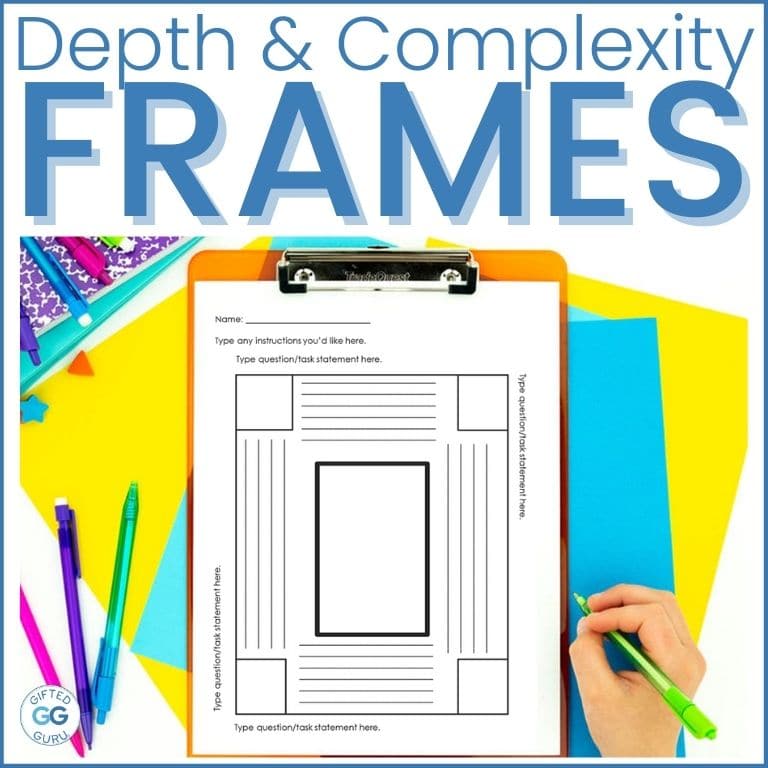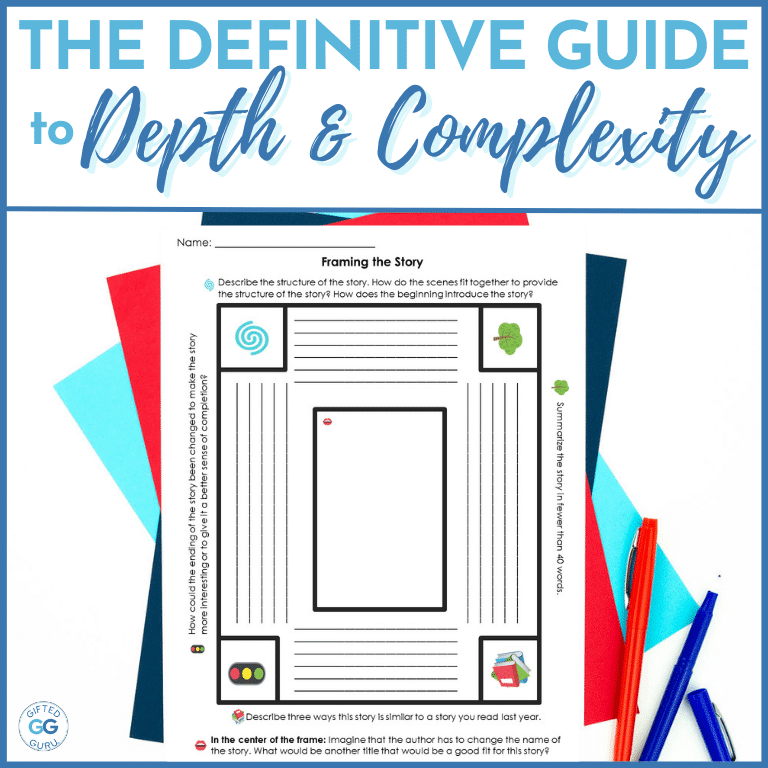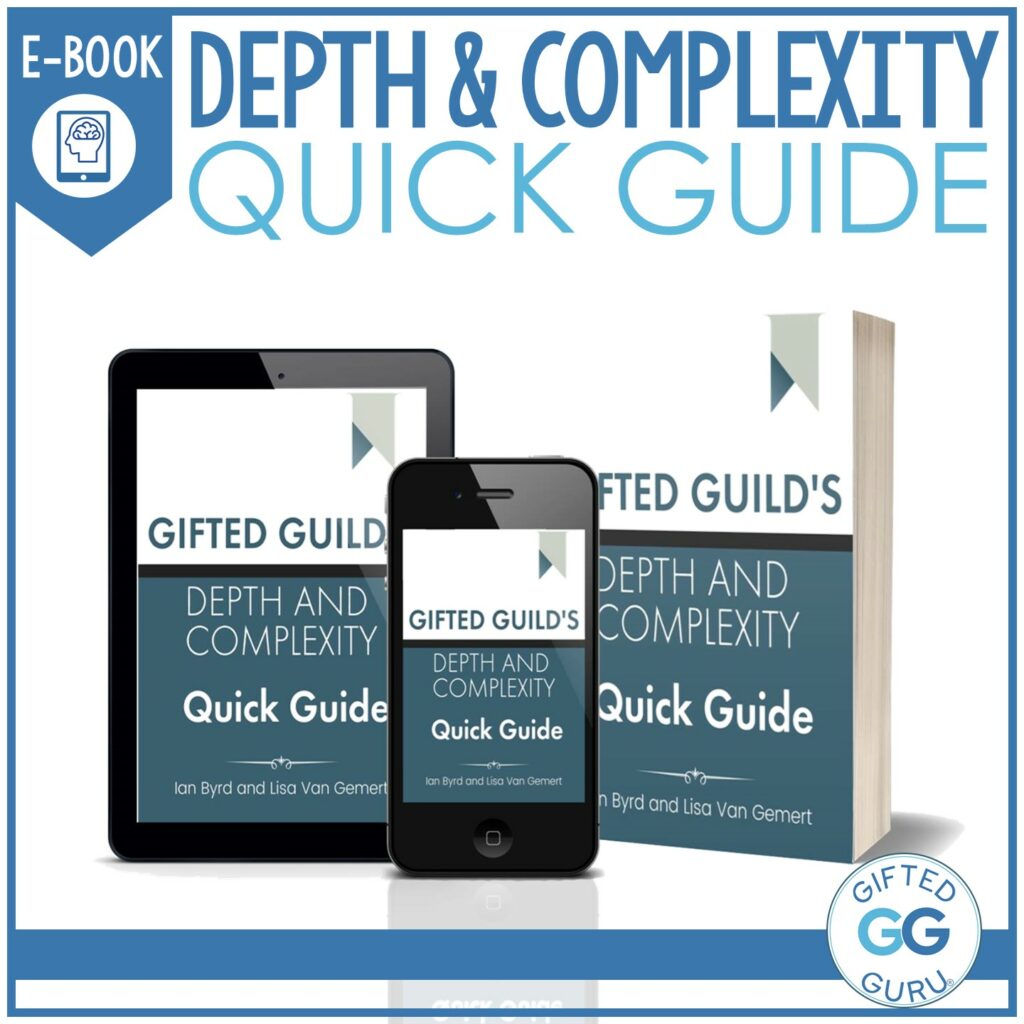Free, editable frames for use with the Depth & Complexity icons are hard to find. This free, editable PowerPoint shares two free frames to use with the Depth & Complexity icons, as well as instructions and copy-and-pastable (is that a word???) icons.
What are Depth and Complexity Frames?
Depth and Complexity frames are activities that students complete based on the Depth and Complexity framework.
Typically, frames have four sections surrounding a central area of focus. This is why they are called frames – they look like a picture frame.
While this is how Depth and Complexity frames are usually set up, they don’t have to have four sections, and they can be any shape.
Each section of the frame has a task statement/question based on a thinking prompt of Depth and Complexity.
The center may have just the topic of the frame listed, or it may have its own activity.
Why Use a Depth and Complexity Frame?
There are no rules about when a teacher should or shouldn’t use a Depth and Complexity frame, but there are a few instances where they work really, really well.
I like them particularly for drawing attention to something my students may have otherwise overlooked or glossed over.
Depth and Complexity frames are very useful for:
- Drawing attention to a particular feature of a piece of content
- Keeping focus on an aspect of the content longer
- Replacing a quiz or worksheet
- Differentiating instruction
I’m not adding it to the list, but another reason they’re great to use is that students like them! They like spinning the paper around, writing in different orientations. It feels different, and different often feels like fun (even when it’s work – shhh! don’t tell!).
How Do You Use a Depth and Complexity Frame?
In general, you print out the frame (although I have created digital frames you can find in my little store) and distribute it to students.
They complete the frame and turn it in. It’s that simple!
It’s important that you explain what the frame is and how they work the first time students use them. It’s also a very good idea to show an example of what a completed one might look like.
This will depend on the grade level of your students, but it’s important to share with them how full you want their responses to be and how deep their thinking should go.
How To Introduce a Depth and Complexity Frame to Students
The first time I have students use a frame, I make sure to explain these things:
- The point of the frame is to help you focus on something.
- Just like a picture frame is designed to optimize the viewer’s experience of a piece of art, a Depth and Complexity frame’s purpose is to optimize your thinking experience.
- The point isn’t the format of the frame itself. The point is the content. Be sure to focus on that!
I also do these things:
- I will show them what a frame looks like, and then I do a frame together using a smart board or document camera.
- For this first frame we’re doing together, I pick a topic that is about something they all know about, rather than content.
- Make sure that you have strong questions, even for this practice one.
- I typically use a four-section frame for this first introduction. It helps them see that it’s a metaphor for a picture frame.
Here’s a sample of possible prompts to go with a topic every student knows about: candy!
In the center of the frame, sketch out a piece of candy or write the word CANDY.
Here are the task statements/questions you could use for this frame:
- ❓What’s a candy that a lot of people don’t like the taste of? [Unanswered Questions]
- If you could only have ⚖️one type of candy for the rest of your life, what would it be? (No picking “chocolate” – be specific!) [Ethics]
- How do 🕶️dentists feel about candy compared to how kids feel about candy? [Multiple Perspectives]
- What’s a candy that ⏳used to be popular but isn’t popular anymore? [Change over Time]
How Do You Create a Depth and Complexity Frame?
Creating a Depth and Complexity Frame is not difficult. The key is the quality of the questions. The format of the frame is just a bonus. Just like with a picture frame, the focus is on the image. In this case, the “image” is the content.
Here are the steps to follow to creat a frame.
- Choose your topic, guiding question/idea, graph, map, or illustration. Put this in the center box.
- Choose four Depth & Complexity thinking prompts that will work for analysis of this topic, question, or idea (represented by emoji or icons.
- Copy and paste an emoji or icon into each of the four spaces of your frame surrounding the center box.
- Create a question or task statement for each section to go with the selected prompt.
Other Depth and Complexity Helps and Resources
I’ve got lots of helps for you as you work with Depth and Complexity Frames and Depth and Complexity in general.
Here are some ideas to get you started.
I’m totally new to Depth and Complexity!
If you’re totally new to Depth and Complexity, I’ve got three suggestions.
I’ve got a short video introduction you can watch, and then I’ve got some resources to explore as well.
1. You can read this article I wrote about Depth and Complexity. This is the hub article, meaning you’ll always be able to find all I’ve written about it on the website from this article, so it might be a good idea to bookmark it.
2) I wrote a comprehensive book about it with my co-author, Ian Byrd. This book is the only book on Depth and Complexity available, but even if it weren’t, it’s very, very good (I know I wrote it, but still!). I can’t tell you how helpful it will be to you on your journey, so if you’ve got an Amazon gift card lying around, go grab a copy or put it on your wish list.

3. The next resource I’d recommend is my ebook Depth and Complexity Quick Guide. It’s not a substitute for the book, but it’s a very handy resource to have at your fingertips. It’s got gorgeous graphics and is designed for easy use by teachers.
I have some experience with Depth and Complexity
If you have some experience with it, then I’d suggest these ideas.
- I’d still say to look at the hub article.
- Then, I’d poke around the Depth and Complexity category page.
- If you are using Depth in Complexity in class, explore the resources I’ve got in my little store. I make some really great Depth and Complexity resources for the classroom at very, very reasonable prices. If you’re done reading and feel like shopping, click here.
Wrapping Up:
Depth and Complexity frames are super fun to use. I hope you find these fun to play with. Be sure to join in the conversation to be the first to know when new freebies are available!
**If you want to become a Depth and Complexity master, you can take the Depth and Complexity Course. Learn more here.









